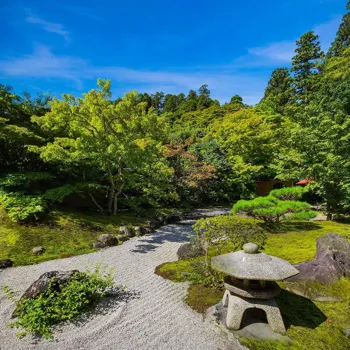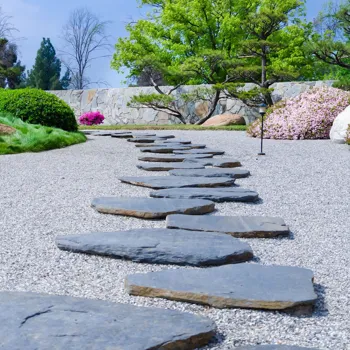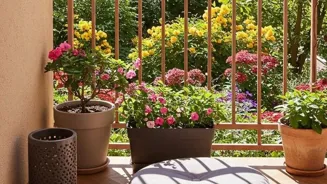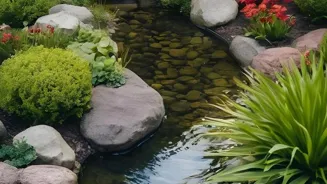Transform your backyard into a tranquil oasis with 10 essential Zen garden tips. Find your peace in nature's embrace
Chai time reading, folks! Feeling stressed with the daily grind? Wish you could escape
to a serene, peaceful place without even leaving your home? Well, worry not! You can bring the tranquility to your own backyard by creating a beautiful Zen garden.
A Zen garden, also known as a Japanese rock garden, is a miniature stylized landscape designed to evoke calmness and promote meditation. It's not just about pretty rocks and sand; it's a carefully crafted space that reflects harmony and balance.
This article will give you ten essential tips to transform your backyard into your personal oasis of zen. So, grab a cup of chai, sit back, and let’s get started on your journey to a more peaceful you!
Careful planning is key for a harmonious Zen garden design
First and foremost, before you even think about raking patterns or choosing stones, careful planning is absolutely crucial. Consider the available space in your backyard. A Zen garden doesn’t need to be massive; a small, dedicated corner can work wonders.
Observe the sunlight and shade patterns throughout the day. You'll want to place your garden in an area that receives a good balance of both. Think about the existing elements of your yard – trees, fences, pathways – and how they can be incorporated into the design.
It’s important to ensure that you create a garden that flows seamlessly blending the natural world with your home, making your backyard an inviting space. Visualise your Zen garden. Do you want a minimalist design with just a few carefully placed rocks and a vast expanse of sand?
Or would you prefer a more elaborate garden with moss, plants, and water features? Sketching out your plan on paper is a great way to get your ideas down and work out the logistics. This helps to avoid costly mistakes later on.
Get an understanding of how much space you have and that you are creating an environment which is tailored, as well as pleasing to the eye.
Plan, gather rocks, gravel, plants for Zen garden. Careful selection key for lasting beauty
Next after planning, it's time to gather your materials. The key elements of a Zen garden typically include rocks, gravel or sand, and perhaps some carefully chosen plants and moss. Rocks represent mountains or islands, and their placement is vital to the overall composition.

Opt for stones in varying sizes, shapes, and textures to create visual interest. The gravel or sand symbolizes water, and it is raked into patterns to represent ripples or waves. Choose a fine-grained material that is easy to rake and holds its shape well.
When selecting plants, go for species that are low-maintenance and complement the minimalist aesthetic of the garden. Bamboo, ferns, and Japanese maples are excellent choices. If you’re incorporating moss, make sure to choose a variety that thrives in your local climate.
You might also consider adding some decorative elements such as lanterns, stepping stones, or a small water basin. Shop around at local nurseries, garden centers, and stone yards to get the best deals and find materials that suit your personal style.
Remember, the quality of your materials will affect the longevity and the overall aesthetics of your Zen garden. Ensure that you source durable material in order to create a space which can be appreciated for years to come.
Creating a Zen garden: design base, arrange rocks asymmetrically for harmony and balance
Now comes the fun part which is creating the structure and base, start the process of designing. Before you start placing anything, prepare the base of your garden. Remove any existing grass, weeds, or debris from the area. Leveling the ground is essential for creating a smooth and uniform surface.

You can use a shovel and rake to achieve this. If your soil is poor, consider adding a layer of sand or gravel to improve drainage. Installing a border around your garden will help to contain the gravel or sand and give it a defined edge. You can use stones, wood, or even bamboo for this purpose.
Once the base is prepared, it’s time to start arranging the rocks. The placement of rocks is a critical aspect of Zen garden design. Follow the principles of asymmetry and balance. Avoid placing rocks in straight lines or symmetrical patterns.
Instead, group them in odd numbers and create visually interesting arrangements. Leave ample space between the rocks to allow for raking and to create a sense of openness. Experiment with different arrangements until you find one that feels harmonious and pleasing to the eye.
This is where your creativity can truly shine. Do not be afraid to experiment because creativity holds endless possibilities.
Raking sand in Zen gardens for peace and creativity
Raking the gravel and sand is an essential element that brings a Zen dimension. After the rocks, comes the sand. The raked patterns symbolize water and add movement and dynamism to the garden. Use a specialized rake to create intricate designs such as ripples, waves, or swirling patterns.
The act of raking itself can be a meditative practice, allowing you to focus your mind and find inner peace. Experiment with different raking techniques to create various effects. Keep in mind that the goal is not to create a perfectly symmetrical or uniform pattern.
Instead, embrace the natural imperfections and variations that arise. You can also use different types of rakes to achieve different textures and patterns.
A wide-toothed rake is good for creating broad, sweeping lines, while a fine-toothed rake is ideal for creating more delicate and detailed patterns. Regularly re-rake your garden to maintain its appearance and to refresh your meditative practice.
Raking the sand not only revitalises the space but your inner self.
Enhance Zen garden tranquility with carefully chosen plants and decor
Enhancing with the right flora can really boost how tranquil your Zen garden becomes. Carefully selected plants can add a touch of life and colour to your Zen garden without overwhelming its minimalist aesthetic.
Choose plants that are low-maintenance, drought-tolerant, and that complement the overall design. Bamboo is an excellent choice for providing vertical interest and a sense of serenity. Ferns add a touch of lushness and can thrive in shady areas.
Japanese maples offer beautiful foliage and vibrant colours. Moss can be used to cover rocks or to create soft, green carpets. When planting, make sure to choose locations that receive the appropriate amount of sunlight and moisture. Avoid overcrowding the garden with too many plants.
Remember, less is often more in Zen garden design. You can also add some decorative elements such as lanterns, stepping stones, or a small water basin to enhance the ambiance of your garden.
These elements should be chosen carefully to complement the overall design and to add a touch of personal flair. Plants bring life to your masterpiece.
Regular maintenance is key to a peaceful Zen garden
Finally, maintain your Zen garden and let it bring you the peace. Regular maintenance is essential for keeping your Zen garden looking its best. This includes weeding, raking, and pruning. Weeding regularly will prevent unwanted plants from taking over your garden.
Raking the gravel or sand will maintain the desired patterns and keep the surface looking clean and tidy. Pruning plants will keep them healthy and prevent them from becoming overgrown. You should also check the rocks and other elements of your garden regularly for any signs of damage or wear.
Replace any broken or damaged items promptly. Take time to simply sit and enjoy your Zen garden on a regular basis. This is an opportunity to relax, meditate, and connect with nature.
Observe the changing light and shadows, listen to the sounds of the wind and birds, and allow yourself to be present in the moment. With proper care and attention, your Zen garden will become a source of lasting peace and tranquility in your life.
Maintaining the peace and ambience within your sacred backyard will enrich your life. So get starting on your plans today!
AI Generated Content. Glance/InMobi shall have no liability for the content









